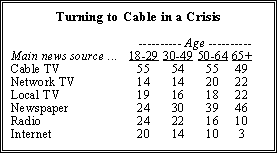Americans are following the news more closely than they were before Sept. 11, and cable networks such as CNN, MSNBC and Fox News Channel are their first choice for news about terrorist attacks and the war on terrorism. But cable is not the only source Americans are relying upon. Fully 44% say they at least sometimes get news about issues related to terrorism from talk radio shows, 35% get news from the Internet, and 24% get at least some news from religious radio and television programming.
New Audience for News
Two-thirds of the public agree that they are now more generally interested in the news than before the terrorist attacks, with one-in-four strongly agreeing. This increased interest is particularly noteworthy among less-educated and lower-income Americans who, under normal circumstances, express the least interest in keeping up with the news. Fully 71% of Americans who never attended college say they are more interested in keeping up with the news than they were before the attacks, compared with 57% of those with college degrees.
But the higher interest in news related to terrorism is not distracting attention from other news stories. Just 18% say they find it hard to get interested in news stories that do not deal with terrorism in some way, while 80% reject this statement. The public had a similar reaction during the Gulf war, when 23% said it was hard to get interested in other news, and 74% said it was not.

Better than half (57%) of those who say they are more interested in the news cite cable as a main source of information, compared with 46% of those who are no more interested in the news since the attacks. Overall, cable is the top source of news for all Americans (53%), regardless of age, gender, race, or other characteristics. Newspapers rate a distant second, with about one-in-three saying they get most of their news this way. Network television news, which was a top source for three-in-ten Americans immediately following the attacks, is now no more prominent a source of information about terrorism than radio or local television news. As in the past, newspapers and network television news are used more heavily by older Americans, while radio and the Internet are predominantly used by the young.
Late-night TV shows, such as those hosted by David Letterman and Jay Leno, are less important as sources for news on terrorism than they were as sources of political information during the 2000 presidential campaign. During the run-up to the 2000 primaries, nearly one-in-three Americans said they at least sometimes got news about the presidential campaign from these late-night shows. Just 17% say the same today about news related to terrorist attacks and the war on terrorism. However, as was the case during the campaign, Americans under age 30 are more than twice as likely to cite Leno and Letterman as news sources than are those age 30 and older (29% to 14% respectively).
Economy Interest Highest Since ’93
News about terrorism in the United States continues to attract the most interest from the public, with two-thirds (66%) tracking these stories very closely. Roughly half the public (49%) paid very close attention to the U.S. military effort in Afghanistan. While women were more interested in news about terrorism, men paid more attention to news about the military campaign.

The recent crash of an American Airlines plane near Kennedy Airport in New York also attracted very close attention from nearly half the public (48%). Despite the surge in public interest in the news, there was less attention to this crash than in the 1996 TWA crash off the coast of New York, which nearly seven-in-ten Americans (69%) tracked very closely.
About four-in-ten people (41%) paid very close attention to reports of anthrax cases around the country. Minorities paid slightly more attention to this story than did whites. Attention was lower in the West than in other regions of the country. Also, 41% of the public followed reports about the condition of the U.S. economy very closely. This is almost twice the percentage of those who followed the story this past summer and is at its highest level since 1993.
The capture of Kabul by Afghan opponents of the Taliban drew close attention from 36% of the public. At the bottom of this month’s news interest index is the debate in Washington over whether airport security personnel should be federal employees or not. Only 31% of the public followed this story very closely. Republican and Democratic interest mirrored that of the public.
Sustained Support for Bush, Military Action
George W. Bush continues to receive high marks for his job performance, with 84% approving of the way he is handling his job as president. The president’s job approval ratings have not dipped below 80% since the Sept. 11 attacks. Even among African-Americans, who were most critical of Bush in the early months of his presidency, 60% currently approve of his job performance, up nearly two-fold since before the attacks.
Americans also continue to support the use of military force to retaliate against those responsible for the attacks, even if it means U.S. troops might suffer thousands of casualties. Since mid-September, support for military action has barely changed (82% then, 85% now). That number declines only slightly (to 77%) when the possibility of thousands of military casualties is raised.
Minorities and liberals are somewhat more likely to oppose the use of military force – 22% of nonwhites and 26% of liberals oppose military action if it means the loss of thousands of U.S. casualties. Nonetheless, these groups back military force by wide margins even when the prospect of large-scale U.S. casualties is raised.




